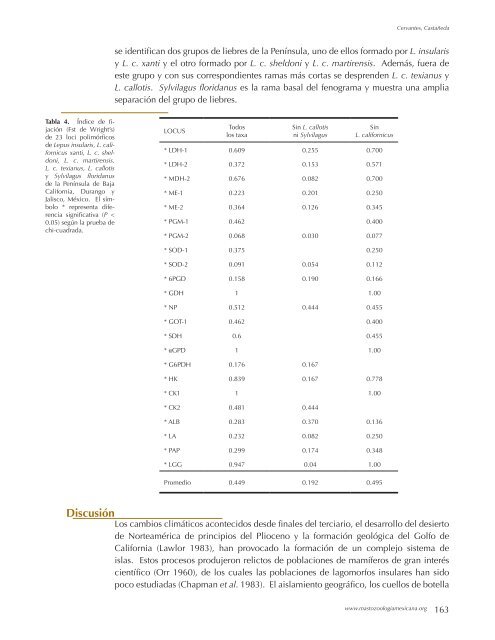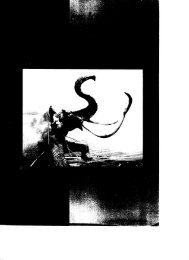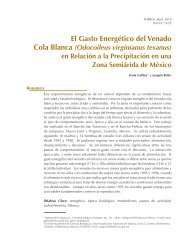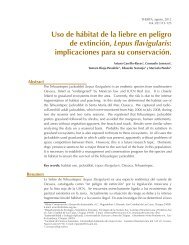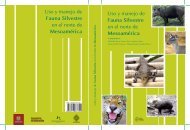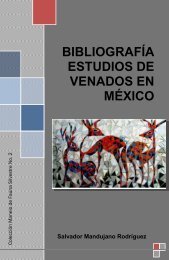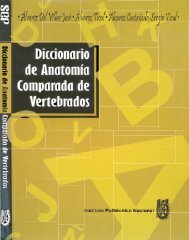Therya agosto 2012.indb - AMMAC: Acerca de la Asociación ...
Therya agosto 2012.indb - AMMAC: Acerca de la Asociación ...
Therya agosto 2012.indb - AMMAC: Acerca de la Asociación ...
Create successful ePaper yourself
Turn your PDF publications into a flip-book with our unique Google optimized e-Paper software.
Tab<strong>la</strong> 4. Índice <strong>de</strong> fijación<br />
(Fst <strong>de</strong> Wright’s)<br />
<strong>de</strong> 23 loci polimórficos<br />
<strong>de</strong> Lepus insu<strong>la</strong>ris, L. californicus<br />
xanti, L. c. sheldoni,<br />
L. c. martirensis,<br />
L. c. texianus, L. callotis<br />
y Sylvi<strong>la</strong>gus floridanus<br />
<strong>de</strong> <strong>la</strong> Penínsu<strong>la</strong> <strong>de</strong> Baja<br />
California, Durango y<br />
Jalisco, México. El símbolo<br />
* representa diferencia<br />
significativa (P <<br />
0.05) según <strong>la</strong> prueba <strong>de</strong><br />
chi-cuadrada.<br />
Discusión<br />
Cervantes, Castañeda<br />
se i<strong>de</strong>ntifican dos grupos <strong>de</strong> liebres <strong>de</strong> <strong>la</strong> Penínsu<strong>la</strong>, uno <strong>de</strong> ellos formado por L. insu<strong>la</strong>ris<br />
y L. c. xanti y el otro formado por L. c. sheldoni y L. c. martirensis. A<strong>de</strong>más, fuera <strong>de</strong><br />
este grupo y con sus correspondientes ramas más cortas se <strong>de</strong>spren<strong>de</strong>n L. c. texianus y<br />
L. callotis. Sylvi<strong>la</strong>gus floridanus es <strong>la</strong> rama basal <strong>de</strong>l fenograma y muestra una amplia<br />
separación <strong>de</strong>l grupo <strong>de</strong> liebres.<br />
LOCUS<br />
Todos<br />
los taxa<br />
Sin L. callotis<br />
ni Sylvi<strong>la</strong>gus<br />
Sin<br />
L. californicus<br />
* LDH-1 0.609 0.255 0.700<br />
* LDH-2 0.372 0.153 0.571<br />
* MDH-2 0.676 0.082 0.700<br />
* ME-1 0.223 0.201 0.250<br />
* ME-2 0.364 0.126 0.345<br />
* PGM-1 0.462 0.400<br />
* PGM-2 0.068 0.030 0.077<br />
* SOD-1 0.375 0.250<br />
* SOD-2 0.091 0.054 0.112<br />
* 6PGD 0.158 0.190 0.166<br />
* GDH 1 1.00<br />
* NP 0.512 0.444 0.455<br />
* GOT-1 0.462 0.400<br />
* SDH 0.6 0.455<br />
* αGPD 1 1.00<br />
* G6PDH 0.176 0.167<br />
* HK 0.839 0.167 0.778<br />
* CK1 1 1.00<br />
* CK2 0.481 0.444<br />
* ALB 0.283 0.370 0.136<br />
* LA 0.232 0.082 0.250<br />
* PAP 0.299 0.174 0.348<br />
* LGG 0.947 0.04 1.00<br />
Promedio 0.449 0.192 0.495<br />
Los cambios climáticos acontecidos <strong>de</strong>s<strong>de</strong> finales <strong>de</strong>l terciario, el <strong>de</strong>sarrollo <strong>de</strong>l <strong>de</strong>sierto<br />
<strong>de</strong> Norteamérica <strong>de</strong> principios <strong>de</strong>l Plioceno y <strong>la</strong> formación geológica <strong>de</strong>l Golfo <strong>de</strong><br />
California (Lawlor 1983), han provocado <strong>la</strong> formación <strong>de</strong> un complejo sistema <strong>de</strong><br />
is<strong>la</strong>s. Estos procesos produjeron relictos <strong>de</strong> pob<strong>la</strong>ciones <strong>de</strong> mamíferos <strong>de</strong> gran interés<br />
científico (Orr 1960), <strong>de</strong> los cuales <strong>la</strong>s pob<strong>la</strong>ciones <strong>de</strong> <strong>la</strong>gomorfos insu<strong>la</strong>res han sido<br />
poco estudiadas (Chapman et al. 1983). El ais<strong>la</strong>miento geográfico, los cuellos <strong>de</strong> botel<strong>la</strong><br />
www.mastozoologiamexicana.org 163


